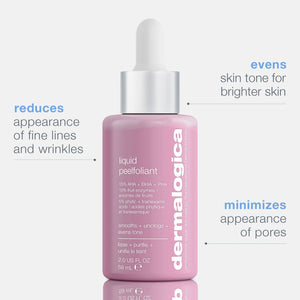3 min read
How to care for your skin after a peel
Follow our expert tips for radiant results post-chemical peel. Depending on your skin’s sensitivity, you may feel tingling, burning, itching, dryness, redness or tightness after a chemical peel, and see peeling or flaking within a week.

Proper post-peel skin care can help minimize any sensations or visible side effects of a peel, making it easier than ever to incorporate this highly-effective skin treatment into your lifestyle.
Chemical peels remove the outermost surface of your skin to help reduce visible signs of skin aging, acne and discoloration. At the same time, they reveal brighter, smoother skin below. Peels range from mild to intense in strength, with some professional-grade formulas available for home use while others are only available at a salon, spa or clinic.
Depending on your skin’s sensitivity, it is normal to experience a variety of side effects as your skin goes through the post-peel renewal process.
At-home peel side effects can include slight tingling or burning, but they should subside quickly. If not, speak to a medical professional or professional skin therapist about what might be causing post-peel discomfort.
Professional peel side effects can include redness, dryness, itching or irritation as well as swelling, tightness, peeling or scabbing. With 2-3 days, skin may look flaky or tan as the outermost surface peels off to make room for more radiant, new skin. You may also notice temporarily more pronounced discoloration or age spots as they rise to the skin’s surface before getting sloughed away.
Your skin is more delicate after a peel, so avoid direct sun exposure.
Proper post-peel skin care
Whether you’re using an at-home peel or getting a professional peel, you can minimize your skin’s downtime afterward by practicing these expert tips:
Wash your face with cool water. Warm or hot water might not feel as good as cool or cold water, which can help soothe post-peel sensations.
Moisturize and hydrate. Since peels can temporarily compromise your skin’s protective barrier, it’s important to reinforce that barrier with a medium-to-thick moisturizer. Also, drink more water to help avoid dehydration, which could make your skin feel tight.
Apply sunscreen with SPF30 or more. Your skin is more delicate after a peel, so avoid direct sun exposure, which can lead to even more visible signs of skin aging. If you must be exposed, use a Broad Spectrum physical sunscreen.
Avoid strenuous workouts, dry saunas and steam rooms. Increased blood circulation to the face can intensify warming, tingling, itching, redness or other uncomfortable side effects on freshly peeled skin. Skip such activities on the day you use a peel.
Don’t over-exfoliate. Peels are maximum-strength exfoliants, so you don’t need to use a separate exfoliant (like a scrub, brush or exfoliating cleanser) within 3-4 days of your peel. Over-exfoliating can lead to more redness or sensitivity, so wait until your skin feels up to it.
Once your skin feels “back to normal” after a peel, it’s generally considered OK to resume your normal skin care regimen. For more personalized advice, ask your professional skin therapist how to incorporate peels into your lifestyle.
Liquid Peelfoliant is a professional-grade at-home peel that helps unclog pores to help reveal brighter, healthier skin.





